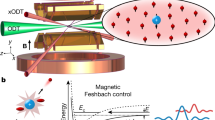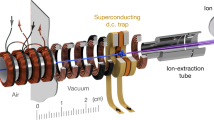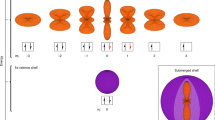Abstract
Great advances in precision measurements in the quantum regime have been achieved with trapped ions and atomic gases at the lowest possible temperatures1,2,3. These successes have inspired ideas to merge the two systems4. In this way, we can study the unique properties of ionic impurities inside a quantum fluid5,6,7,8,9,10,11,12 or explore buffer gas cooling of a trapped-ion quantum computer13. Remarkably, in spite of its importance, experiments with atom–ion mixtures have remained firmly confined to the classical collision regime14. We report a collision energy of 1.15(±0.23) times the s-wave energy (or 9.9(±2.0) μK) for a trapped ytterbium ion in an ultracold lithium gas. We observed a deviation from classical Langevin theory by studying the spin-exchange dynamics, indicating quantum effects in the atom–ion collisions. Our results open up numerous opportunities, such as the exploration of atom–ion Feshbach resonances15,16, in analogy to neutral systems17.
This is a preview of subscription content, access via your institution
Access options
Access Nature and 54 other Nature Portfolio journals
Get Nature+, our best-value online-access subscription
$29.99 / 30 days
cancel any time
Subscribe to this journal
Receive 12 print issues and online access
$209.00 per year
only $17.42 per issue
Buy this article
- Purchase on Springer Link
- Instant access to full article PDF
Prices may be subject to local taxes which are calculated during checkout



Similar content being viewed by others
References
Ludlow, A. D., Boyd, M. M., Ye, J., Peik, E. & Schmidt, P. Optical atomic clocks. Rev. Mod. Phys. 87, 637–701 (2015).
Bernien, H. et al. Probing many-body dynamics on a 51-atom quantum simulator. Nature 551, 579–584 (2017).
Zhang, J. et al. Observation of a many-body dynamical phase transition with a 53-qubit quantum simulator. Nature 551, 601–604 (2017).
Tomza, M. et al. Cold hybrid ion–atom systems. Rev. Mod. Phys. 91, 035001 (2019).
Zipkes, C., Paltzer, S., Sias, C. & Köhl, M. A trapped ion inside a Bose–Einstein condensate. Nature 464, 388–391 (2010).
Schmid, S., Härter, A. & Denschlag, J. H. Dynamics of a cold trapped ion in a Bose–Einstein condensate. Phys. Rev. Lett. 105, 133202 (2010).
Ratschbacher, L. et al. Dynamics and decoherence of a single spin-qubit in a tunable environment. Phys. Rev. Lett. 110, 160402 (2013).
Meir, Z. et al. Dynamics of a ground-state cooled ion colliding with ultra-cold atoms. Phys. Rev. Lett. 117, 243401 (2016).
Kleinbach, K. S. et al. Ionic impurity in a Bose–Einstein condensate at submicrokelvin temperatures. Phys. Rev. Lett. 120, 193401 (2018).
Sikorsky, T., Meir, Z., Ben-shlomi, R., Akerman, N. & Ozeri, R. Spin-controlled atom–ion chemistry. Nat. Commun. 9, 920 (2018).
Haze, S., Sasakawa, M., Saito, R., Nakai, R. & Mukaiyama, T. Cooling dynamics of a single trapped ion via elastic collisions with small-mass atoms. Phys. Rev. Lett. 120, 043401 (2018).
Schmidt, J., Weckesser, P., Thielemann, F., Schaetz, T. & Karpa, L. Optical traps for sympathetic cooling of ions with ultracold neutral atoms. Preprint at https://arxiv.org/abs/1909.08352 (2019).
Daley, A. J., Fedichev, P. O. & Zoller, P. Single-atom cooling by superfluid immersion: a nondestructive method for qubits. Phys. Rev. A 69, 022306 (2004).
Schmid, T. et al. Rydberg molecules for ion–atom scattering in the ultracold regime. Phys. Rev. Lett. 120, 153401 (2018).
Idziaszek, Z., Simoni, A., Calarco, T. & Julienne, P. S. Multichannel quantum-defect theory for ultracold atom–ion collisions. New J. Phys. 13, 083005 (2011).
Tomza, M., Koch, C. P. & Moszynski, R. Cold interactions between an Yb+ ion and a Li atom: prospects for sympathetic cooling, radiative association, and Feshbach resonances. Phys. Rev. A 91, 042706 (2015).
Chin, C., Grimm, R., Julienne, P. S. & Tiesinga, E. Feshbach resonances in ultracold gases. Rev. Mod. Phys. 82, 1225–1286 (2010).
Itano, W. M., Bergquist, J. C., Bollinger, J. J. & Wineland, D. J. Cooling methods in ion traps. Phys. Scr. 1995, 106–120 (1995).
Major, F. G. & Dehmelt, H. G. Exchange-collision technique for the RF spectroscopy of stored ions. Phys. Rev. 170, 91–107 (1968).
Cetina, M., Grier, A. T. & Vuletić, V. Fundamental limit to atom–ion sympathetic cooling in Paul traps. Phys. Rev. Lett. 109, 253201 (2012).
Leibfried, D. et al. Experimental determination of the motional quantum state of a trapped atom. Phys. Rev. Lett. 77, 4281–4285 (1996).
DeVoe, R. G. Power-law distributions for a trapped ion interacting with a classical buffer gas. Phys. Rev. Lett. 102, 063001 (2009).
Zipkes, C., Ratschbacher, L., Sias, C. & Köhl, M. Kinetics of a single trapped ion in an ultracold buffer gas. New J. Phys. 13, 053020 (2011).
Chen, K., Sullivan, S. T. & Hudson, E. R. Neutral gas sympathetic cooling of an ion in a Paul trap. Phys. Rev. Lett. 112, 143009 (2014).
Rouse, I. & Willitsch, S. Superstatistical energy distributions of an ion in an ultracold buffer gas. Phys. Rev. Lett. 118, 143401 (2017).
Höltkemeier, B., Weckesser, P., López-Carrera, H. & Weidemüller, M. Buffer-gas cooling of ions in a multipole radio frequency trap beyond the critical mass ratio. Phys. Rev. Lett. 116, 233003 (2016).
Fürst, H. et al. Prospects of reaching the quantum regime in Li–Yb+ mixtures. J. Phys. B 51, 195001 (2018).
Berkeland, D. J., Miller, J. D., Bergquist, J. C., Itano, W. M. & Wineland, D. J. Minimization of ion micromotion in a Paul trap. J. Appl. Phys. 83, 5025–5033 (1998).
Krych, M. & Idziaszek, Z. Description of ion motion in a Paul trap immersed in a cold atomic gas. Phys. Rev. A 91, 023430 (2015).
Fürst, H. et al. Dynamics of a single ion-spin impurity in a spin-polarized atomic bath. Phys. Rev. A 98, 012713 (2018).
Joger, J. et al. Observation of collisions between cold Li atoms and Y+ ions. Phys. Rev. A 96, 030703(R) (2017).
Fürst, H. A. Trapped Ions in A Bath of Ultracold Atoms. PhD thesis, Univ. Amsterdam (2019).
Ewald, N. V., Feldker, T., Hirzler, H., Fürst, H. & Gerritsma, R. Observation of interactions between trapped ions and ultracold Rydberg atoms. Phys. Rev. Lett. 122, 253401 (2019).
Taylor, P. et al. Investigation of the \({}^{2}{S}_{1/2}{-}^{2}{D}_{5/2}\) clock transition in a single ytterbium ion. Phys. Rev. A 56, 2699–2704 (1997).
Acknowledgements
This work was supported by the European Union via the European Research Council (Starting Grant 337638) and the Netherlands Organization for Scientific Research (Vidi Grant 680-47-538, Start-up Grant 740.018.008 and Vrije Programma 680.92.18.05) (R.G.). D.W. and M.T. were supported by the National Science Centre Poland (Opus Grant 2016/23/B/ST4/03231) and PL-Grid Infrastructure. We thank J. Walraven and C. Coulais for comments on the manuscript.
Author information
Authors and Affiliations
Contributions
T.F. and R.G. conceived the experiment. T.F., H.F., H.H., N.V.E. and M.M. performed the experiment. H.F. and R.G. performed molecular dynamics simulations, D.W. and M.T. performed quantum scattering simulations. All authors contributed to discussions about the experiment, the analysis of the data and the preparation of the manuscript.
Corresponding author
Ethics declarations
Competing interests
The authors declare no competing interests.
Additional information
Publisher’s note Springer Nature remains neutral with regard to jurisdictional claims in published maps and institutional affiliations.
Extended data
Extended Data Fig. 1 Time-of-flight (TOF) data of the atomic cloud after release from the dipole trap.
We plot \({\sigma }_{{\rm{x}}}\) (blue) and \({\sigma }_{{\rm{y}}}\) (yellow). We average the temperature \({T}_{{\rm{x}}}\) and \({T}_{{\rm{y}}}\) to determine the atom temperature \({T}_{{\rm{a}}}\) a, TOF data for cold atoms after a buffer gas cooling time of 1 s. We determine an average atom temperature of \({T}_{{\rm{a}}}\) = 2.0(0.8) μK. The error bars are quite large for this measurement as the atomic density is at the lower limit of what we can reliably measure in our system. b, TOF data for cold atoms before the buffer gas cooling. We determine \({T}_{{\rm{a}}}\) = 2.6(0.3) μK. c, TOF data for the atomic cloud used for the spin-exchange rate measurement, we determine a temperature of \({T}_{{\rm{a}}}\) = 11.6(0.5) μK. Error bars denote standard deviations of fitted cloud sizes.
Extended Data Fig. 2 Micromotion analysis with resolved sideband spectroscopy.
In part a and b Rabi oscillations on the carrier and the micromotion sideband for optimal compensation settings are plotted. From a comparison of the Rabi frequencies \({\varOmega }_{{\rm{car}}}=2\pi \times 32.0(0.8)\)kHz and \({\varOmega }_{{\rm{MM}}}=2\pi \times 7.0(0.5)\)kHz in combination with the applied laser powers of \({P}_{411}=32\)μW and \({P}_{411}=840\)μK, respectively we obtain a residual micromotion energy of \({\overline{E}}_{{\rm{eMM}}}/{k}_{{\rm{B}}}=21.5(1.5)\)μK. Part c shows a frequency scan over the carrier transition, carried out with a laser power of \({P}_{411}=61\)μW. A clear peak is visible. For the data plotted in part d the frequency of the laser is shifted by \(-{\varOmega }_{{\rm{rf}}}=-1.85\)MHz compared to c and the power is increased to \({P}_{411}=21.7\)mW. At the expected resonance frequency for the micromotion sideband we do not see a clear peak, only the background is higher compared to c due to off-resonant carrier excitation at these high laser powers. If we shift the ion out of the optimal position for minimal micromotion we observe a clear resonance again as plotted in e. We conclude that the Rabi frequency \({\varOmega }_{{\rm{MM}}}\) on the micromotion sideband presented in e is not larger than the Rabi frequency on the carrier \({\varOmega }_{{\rm{car}}}\) presented in c. From this we obtain an upper limit of the axial micromotion at the optimal position of \({\overline{E}}_{{\rm{eMM}}}/{k}_{{\rm{B}}}=33\)μK. Error bars correspond to quantum projection noise.
Extended Data Fig. 3 Calculated energy distribution after buffer gas cooling of the ion using the parameters from the experiment.
The frequency of average secular kinetic energies is shown and fitted with a thermal distribution for a harmonic oscillator with a temperature of \({T}_{\sec }^{\perp }=38.2\) μK. No observable deviation from the thermal distribution is found. The results shown are from 300 simulation runs. In these simulations, the secular kinetic energy of the ion was obtained by filtering out energy contributions with a frequency higher than half the trap drive frequency, \({\varOmega }_{{\rm{rf}}}/2\), as explained in ref. 26.
Extended Data Fig. 4
\({\chi }^{2}\) as a function of the singlet \({a}_{{\rm{S}}}\) and triplet \({a}_{{\rm{T}}}\) scattering lengths with the number of Langevin collisions optimized for each set of scattering lengths.
Source data
Source Data Fig. 2
a, Ion temperature (microkelvin) versus sympathetic cooling time (ms) and error. Insets and b, Probability of finding ion in S state versus laser interrogation time (microseconds) and errors. c, Probability of finding ion in S state versus laser frequency (MHz) and errors.
Source Data Fig. 3
Spin flip probability versus average collision energy (microkelvin) and errors.
Source Data Extended Data Fig. 1
Radial atomic cloud sizes (micrometres) versus time-of-flight expansion (microseconds) and errors.
Source Data Extended Data Fig. 2
a,b, Probability of finding ion in S state versus laser interrogation time (microseconds) and errors. c-e, Probability of finding ion in S state versus laser frequency (MHz) and errors.
Source Data Extended Data Fig. 3
Simulation. Calculated probability of finding an ion at an average kinetic energy (microkelvin).
Source Data Extended Data Fig. 4
\({{\rm{Chi}}}^{2}\) of best fit as a function of singlet (x-axis) and triplet (y-axis) scattering length
Rights and permissions
About this article
Cite this article
Feldker, T., Fürst, H., Hirzler, H. et al. Buffer gas cooling of a trapped ion to the quantum regime. Nat. Phys. 16, 413–416 (2020). https://doi.org/10.1038/s41567-019-0772-5
Received:
Accepted:
Published:
Issue Date:
DOI: https://doi.org/10.1038/s41567-019-0772-5
This article is cited by
-
Many-body bound states and induced interactions of charged impurities in a bosonic bath
Nature Communications (2023)
-
Trap-assisted formation of atom–ion bound states
Nature Physics (2023)
-
Adaptable platform for trapped cold electrons, hydrogen and lithium anions and cations
Communications Physics (2023)
-
Translational symmetry breaking binds atoms and ions
Nature Physics (2023)
-
Quantum logic detection of collisions between single atom–ion pairs
Nature Physics (2022)



